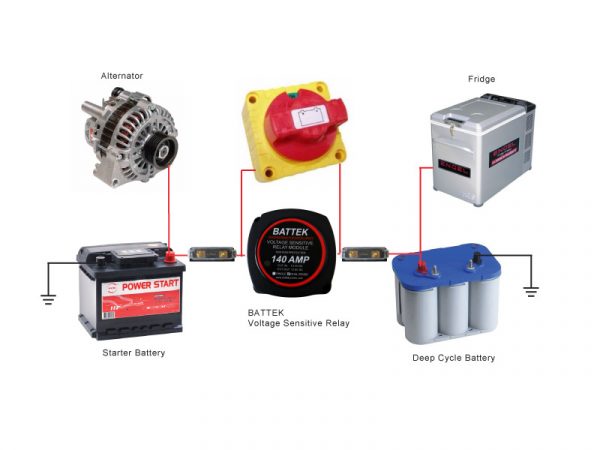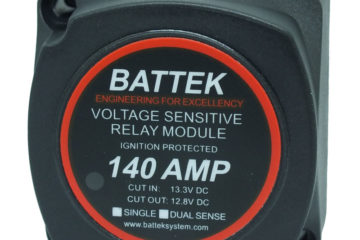One of the best approach to charge two batteries in a boat or a vehicle from a single charging source is to use a Voltage Sensitive Relay (VSR). This device connects a secondary battery to the primary battery and charging current source whenever the voltage of the primary battery exceeds about 13.3 Volts DC. In this way, the secondary battery only receives charging current after the primary battery has been charged to a voltage which normally indicates full-charge has been restored in the primary battery .

Typical Wiring Diagram for BATTEK Dual Battery System
The beauty of this wiring arrangement is to concentrate first on charging of the primary battery, which is usually the engine starting or cranking battery, and only provide charging current to the secondary or house battery when the primary battery has been fully re-charged. In this way the system assures that the engine starting battery will always be kept at a high charge level, and charging of the house battery will never divert current needed for the starting battery.
For optimum performance, the capacity of the secondary battery and the charging current available need to be matched up. This is necessary to prevent the system from going into an oscillation. Here is what can happen if the charging current available is too small and the secondary battery is too large:
When the charging current has raised the voltage on the primary battery to a level above the threshold of the VSR, the secondary battery is connected in parallel. Typically the addition of the second battery will cause some drop in voltage in the charging current output and primary battery. If this voltage drop is excessive, it will fall below the threshold of the VSR and the device will disconnect the secondary battery. Once that happens the voltage rises, again, and this pushes it above the the threshold of the VSR. The two batteries are connected, and the voltage drops. This sets up an oscillation or chatter of the VSR.
To prevent this hysteresis is implemented in the control loop of the VSR so that the cut-in threshold and the cut-off threshold are separated by a margin of appropriate voltage. However, if the secondary battery is too large and the charging current source too small, the system will still oscillate or chatter, in spite of the hysteresis in the control loop. This can occur if the secondary battery is very large and the charging current is marginal.




4 Comments
batteksystem · 5th September 2017 at 5:31 am
http://www.ebay.com/itm/301360777164
Nathan Kassay · 5th January 2019 at 9:34 pm
[…] We’ve already done a few things to this space since moving in a little over a year ago including painting the walls white, replacing the range, switching out the light fixture, and adding under/over cabinet lighting. […]
Barry Bookwalter · 11th January 2019 at 1:23 am
Great Article ! I’d like to convert the two 4-ft single linear T-12 fixtures in my kitchen to LED lights. These are 40W bulbs but I’ve measured 45+ watts probably due to inefficient ballasts.
batteksystem · 11th January 2019 at 12:16 pm
Both Dual Battery and LED System save battery power and allow the system to run more efficiently and longer.
Comments are closed.